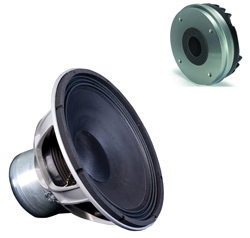
A woofer’s Maximum Linear Excursion, or Xmax, occurs when the voicecoil begins to leave its magnetic gap, where the driver’s output becomes non-linear and distortion begins.
Xmax can also be expressed as the length of the voicecoil minus the height of the gap through which it travels.
The use of neodymium magnets has resulted in drivers with lower weight. Transducers with higher power handling often have lower efficiency and a smaller Xmax due to a higher number of windings in the gap.
Most manufacturers make additional models with the same magnet-and-voicecoil “motors,” but with different cones and baskets, to provide a series of drivers from 12 to 18 or even 21 inches in diameter with similar specifications.
.
I’ve Got The Power!
Power handling ratings have a number of different designations: thermal, continuous, RMS, average, AES, EIA, IEC or sustained.
Differences in power ratings are usually a result of different methods and as a result there has been “specsmanship” by some, highlighting the rating with the highest number.
Power handling terms such as “music,” “program,” or “peak” power ratings are usually two or four times the thermal (a.k.a. RMS or continuous) power rating, but these aren’t the result of actual measurements.
Usually, these ratings are only an indication that the driver can handle peak inputs that are higher than the maximum rated thermal power limit. It’s common for “program” to be double the “continuous,” and “peak” to be twice that again.
The stringent AES (Audio Engineering Society) standard for rating loudspeaker component power handling has been in use for a quarter century.
It specifies a pink noise signal clipped to a 6 dB crest factor, with a bandwidth of one decade. A woofer might use a 50-500 Hz band, while a compression driver could use 1,000-10,000 Hz. The duration is two hours, after which the component should not show appreciable damage.
Tour our PSW Gallery Tour of all models, and also check out this related article on key cone driver principles and specifications.
Mark Frink is Associate Editor of Live Sound International magazine.
